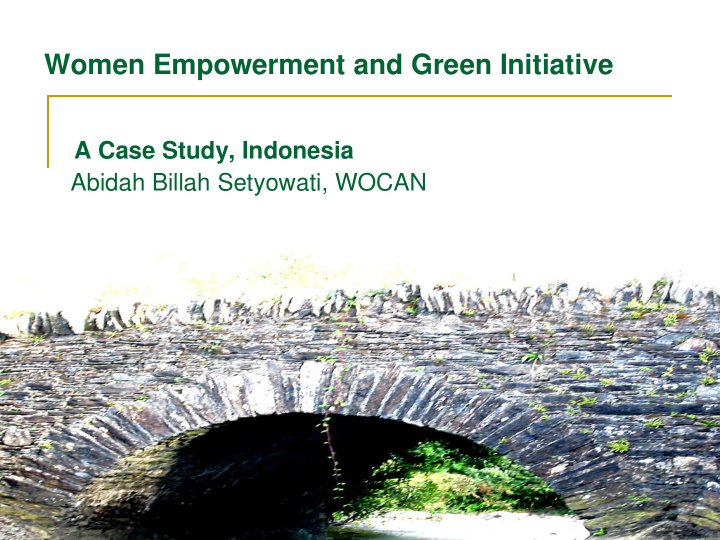



Women Empowerment and Green Initiative A Case Study, Indonesia Abidah Billah Setyowati, WOCAN
Composition osition of Fore restry stry staffs fs Data 2010-Ministry of Forestry Most of woman is working as administration 29% women are in a minority at senior 31% levels of government as there are only two women out of nine Echelon One officials. 12% 10% Only about 10% of technical woman staffs work in the field 17%
Challenges for woman in forestry sector Identification of forestry as work of men. Restrict leadership position of women, they are in a minority at senior levels of government; Restrictions on women ’ s mobility; Women are also less likely than men to have the networks, contacts, and social and professional experience expected of public leaders.
Opportunities Indonesia has second largest forest in the world (136 mil ha) which women ’ s roles in forest management are crucial to ensure good forest governance Protected Protected Forests Production Community Forests30,9 m ha 30,9 m ha Forests forest 80.4 m ha CEDAW and Presidential Instruction No 9/2000 on Gender Mainstreaming in the National Development - The instruction promotes gender equality in the public and private sphere. It requires all government agencies to implement gender mainstreaming for planning, formulation, implementation monitoring and evaluation of national development policies. Historically, woman in some area/provinces such as Aceh, West Sumatera have played strong roles in forest governance and politics at the local level.
Updates New initiatives are implemented include: 1) Revitalize a gender working group; 2) Promote more women to take leadership roles; 3) Collaborate with the Ministry of Women Empowerment to develop gender sensitive planning and budgeting. Measurable indicators and monitoring are needed to ensure their effective implementation; Enhance leadership skills for women working in the forestry sector
Prologue A case study that underscore the importance of women involvement in forest governance
The Setting: Lubuk Beringin A village covering 2,800 hectares (84 % of the area is watershed protection forest), in Bungo District, Indonesia; Majority of people live below the poverty line;
Livelihood: rubber agroforests that also provide durian and other fruits as well as medicinal plants; Insecure tenure: part of the rubber agroforests are classified as protected area; Rampant illegal logging.
Bungo District, Indonesia Source: KKI Warsi
What Has Been Done? Integrated Conservation and Development Programme in 1990s Forest conservation and revitalization of local institution Women empowerment – saving groups with initial capital around 3000 USD A local women ’ s cooperative, Dahlia, was established Other initiatives are not sustainable but the women saving group sustain
Payment for Environmental Services Micro hydro to generate electricity in the village Granted forest village permit covering 2,356 ha Women ’ s groups get additional capital for their cooperation enable women to expand their business Source: KKI WARSI Cut middlemen and improve profit
A contract with a big tier company, bridgestone, was secured The cooperative ’ s total capital reach 65,000 USD Net profits are distributed annually to its members. Some portions of the profits are allocated for allocated for new investment and Source: KKI Warsi watershed protection
Broader Implication Improving local economy Increasing commitment to protect the forest; Reduce illegal logging activities in the area; Women ’ s engagement leads to successful and sustainable initiative; Key to success: accountable management of the cooperative and willingness to build social relations that fosters collaboration
However.. the Challenges Remain Low representation in local forest institution Disappearing act: women ’ s initiative has not been sufficiently acknowledged Gender responsive approach has not been considered in a potential future project in the area (REDD+)
Key Message Women ’ s access to decision making processes and leadership in community forestry initiative and PES is very crucial to ensure inclusive green governance and successful institutional functioning. It not only improves women ’ s effective voice in decision- making, influences the nature of decisions made, especially the rules of forest use and their implementation but also improves forest condition
THANK YOU!
Recommend
More recommend